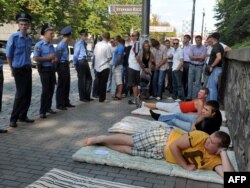A high-level meeting on HIV/AIDS kicks off at UN headquarters on June 8, aimed at reviewing the progress over the last decade in the fight against HIV/AIDS and charting the course of action till 2015.
In a sign that the UN continues to view the fight against HIV/AIDS as one of its main priorities, the UN Security Council on June 7 held a special session to review the implementation of its Resolution 1308 adopted in 2000.
It was the second time in its history the UN highest executive organ unanimously adopted a resolution addressing a public-health concern and its implications for international peace and security.
Since it was first discovered in 1981, Acquired Immune Deficiency Syndrome (AIDS) has claimed the lives of more than 30 million people. Close to 35 million people were living with the Human Immunodeficiency Virus (HIV) at the end of 2010, according to the latest report from the UN agency UNAIDS.
A Game-Changing Discovery
But if AIDS was automatically viewed as a terminal illness in the early days, now that is no longer the case, and new HIV infection rates are declining overall.
Michel Sidibe, UNAIDS executive director, maintains that treatment has come a long way since the first case was reported in 1981.
"AIDS has moved from what was effectively a death sentence to a chronic disease," he says. "New HIV infections are now declining at a significant rate -- by 25 percent in the last 10 years."
The results of a scientific study released in May indicate that if an HIV-infected individual starts treatment early on, it drastically reduces the likelihood that person will infect others:
Sidibe is calling that discovery a "game-changer:"
"If you manage to put people early in treatment, you reduce the capacity to transmit the infection by 96 percent," he says.
In view of this new discovery, the international humanitarian organization Doctors Without Borders called on governments to put between 9 million-12 million HIV-infected people into treatment over the next four years.
Dr. Tido von Schoen-Angerer, executive director of the group's campaign for access to essential medicines, says that now there is a real opportunity to drastically cut the spread of the disease by providing early treatment.
"There's now a dramatic opportunity to turn this, the science into real policies to get us ahead of the wave of new infections," he says.
Funding Is A Contentious Issue
UNAIDS estimates that 12 million new infections and 7 million AIDS-related deaths can be prevented by 2020 if UN member states agree to provide $6 billion in additional funding.
The funding issue is expected to be one of the most contentious during the AIDS summit as the global financial crisis has severely crippled the ability and willingness of governments to commit funds to fight HIV/AIDS.
Another contentious issue is the intellectual property rights over HIV/AIDS drugs.
The cost of treating HIV/AIDS patient has declined drastically from $10,000 in 2001 to approximately $100 a year in 2011.
But there are ongoing legal disputes between major Western pharmaceutical companies holding rights to HIV/AIDS drugs and producers of the much cheaper generic variations of the same drugs in developing countries, notably India.
Despite the overall decline of new infections around the globe, Eastern Europe and Central Asia remain two of HIV/AIDS hot spots with infection rates, according to the report, "clearly" on the rise.
Stigma And Fear Remain
Half of all new infections in Eastern Europe and Central Asia are attributed to drug users sharing needles.
The total number of people infected with HIV in those two regions is estimated at 1.5 million. The HIV epidemic in Eastern Europe and Central Asia, the report says, is concentrated mainly among drug injecting users, sex workers, and to a much lesser extent men having sex with men.
Tatyana Afanasiadi, an HIV-positive person and coordinator of the All-Ukrainian Network of People Living With HIV in the Odesa region of Ukraine, says that for the last decade the social acceptance of people with HIV/AIDS in Ukraine has improved dramatically even though the stigma and fear remain.
The stigma "is most damaging when there is stigma on the part of medical personnel," she says. "It has very serious consequences, it affects the epidemic. There are instances, regrettably, even today when people are being refused medical care [because of their HIV status]."
She says that 50,000 people need antiretroviral therapy in Ukraine but only 6,000 are receiving it. "Even the 6,000 people who are receiving it and the medical personnel administering it are being harassed by law enforcement," she says.
Different levels of prioritizing the fight against HIV/AIDS are also clearly seen in the representation at the high-level UN AIDS meeting in New York: while most of the African countries are represented at the head-of-state level, most of those from Eastern Europe and Central Asia are represented at the deputy-minister level.
In a sign that the UN continues to view the fight against HIV/AIDS as one of its main priorities, the UN Security Council on June 7 held a special session to review the implementation of its Resolution 1308 adopted in 2000.
It was the second time in its history the UN highest executive organ unanimously adopted a resolution addressing a public-health concern and its implications for international peace and security.
Since it was first discovered in 1981, Acquired Immune Deficiency Syndrome (AIDS) has claimed the lives of more than 30 million people. Close to 35 million people were living with the Human Immunodeficiency Virus (HIV) at the end of 2010, according to the latest report from the UN agency UNAIDS.
A Game-Changing Discovery
But if AIDS was automatically viewed as a terminal illness in the early days, now that is no longer the case, and new HIV infection rates are declining overall.
Michel Sidibe, UNAIDS executive director, maintains that treatment has come a long way since the first case was reported in 1981.
"AIDS has moved from what was effectively a death sentence to a chronic disease," he says. "New HIV infections are now declining at a significant rate -- by 25 percent in the last 10 years."
The results of a scientific study released in May indicate that if an HIV-infected individual starts treatment early on, it drastically reduces the likelihood that person will infect others:
Sidibe is calling that discovery a "game-changer:"
"If you manage to put people early in treatment, you reduce the capacity to transmit the infection by 96 percent," he says.
Patients at a Ukrainian HIV/AIDS clinic protest against the eviction of their facility from a building in the centre of Kyiv.
In view of this new discovery, the international humanitarian organization Doctors Without Borders called on governments to put between 9 million-12 million HIV-infected people into treatment over the next four years.
Dr. Tido von Schoen-Angerer, executive director of the group's campaign for access to essential medicines, says that now there is a real opportunity to drastically cut the spread of the disease by providing early treatment.
"There's now a dramatic opportunity to turn this, the science into real policies to get us ahead of the wave of new infections," he says.
Funding Is A Contentious Issue
UNAIDS estimates that 12 million new infections and 7 million AIDS-related deaths can be prevented by 2020 if UN member states agree to provide $6 billion in additional funding.
The funding issue is expected to be one of the most contentious during the AIDS summit as the global financial crisis has severely crippled the ability and willingness of governments to commit funds to fight HIV/AIDS.
Another contentious issue is the intellectual property rights over HIV/AIDS drugs.
The cost of treating HIV/AIDS patient has declined drastically from $10,000 in 2001 to approximately $100 a year in 2011.
But there are ongoing legal disputes between major Western pharmaceutical companies holding rights to HIV/AIDS drugs and producers of the much cheaper generic variations of the same drugs in developing countries, notably India.
Despite the overall decline of new infections around the globe, Eastern Europe and Central Asia remain two of HIV/AIDS hot spots with infection rates, according to the report, "clearly" on the rise.
Stigma And Fear Remain
Half of all new infections in Eastern Europe and Central Asia are attributed to drug users sharing needles.
The total number of people infected with HIV in those two regions is estimated at 1.5 million. The HIV epidemic in Eastern Europe and Central Asia, the report says, is concentrated mainly among drug injecting users, sex workers, and to a much lesser extent men having sex with men.
Tatyana Afanasiadi, an HIV-positive person and coordinator of the All-Ukrainian Network of People Living With HIV in the Odesa region of Ukraine, says that for the last decade the social acceptance of people with HIV/AIDS in Ukraine has improved dramatically even though the stigma and fear remain.
The stigma "is most damaging when there is stigma on the part of medical personnel," she says. "It has very serious consequences, it affects the epidemic. There are instances, regrettably, even today when people are being refused medical care [because of their HIV status]."
She says that 50,000 people need antiretroviral therapy in Ukraine but only 6,000 are receiving it. "Even the 6,000 people who are receiving it and the medical personnel administering it are being harassed by law enforcement," she says.
Different levels of prioritizing the fight against HIV/AIDS are also clearly seen in the representation at the high-level UN AIDS meeting in New York: while most of the African countries are represented at the head-of-state level, most of those from Eastern Europe and Central Asia are represented at the deputy-minister level.













